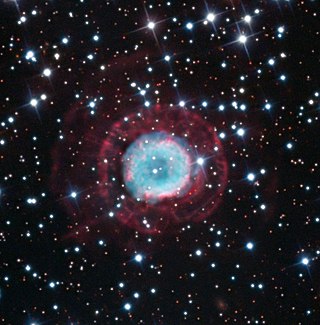
NGC 2438 is a planetary nebula in the southern constellation of Puppis. Parallax measurements by Gaia put the central star at a distance of roughly 1,370 light years. It was discovered by William Herschel on March 19, 1786. NGC 2438 appears to lie within the cluster M46, but it is most likely unrelated since it does not share the cluster's radial velocity. The case is yet another example of a superposed pair, joining the famed case of NGC 2818.
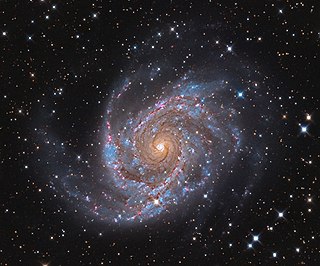
NGC 2997 is a face-on unbarred spiral galaxy about 40 million light-years away in the faint southern constellation of Antlia. It was discovered March 4, 1793 by German-born astronomer William Herschel. J. L. E. Dreyer described it as, "a remarkable object, very faint, very large, very gradually then very suddenly bright middle and 4 arcsec nucleus. This is the brightest galaxy of the NGC 2997 group of galaxies, and was featured on the cover of the first edition of Galactic Dynamics by James Binney and Scott Tremaine.

NGC 5962 is a spiral galaxy in the equatorial constellation of Serpens Caput. It was discovered by the Anglo-German astronomer William Herschel on March 21, 1784. The NGC 5962 galaxy is located at a distance of 120 million light years and is receding with a heliocentric radial velocity of 1,957 km/s. It is the brightest member of the eponymously-named NGC 5962 group, which overlaps with the nearby NGC 5970 group; the two groups may be gravitationally bound.

NGC 7662 is a planetary nebula located in the northern constellation Andromeda. It is known as the Blue Snowball Nebula, Snowball Nebula, and Caldwell 22. This nebula was discovered October 6, 1784 by the German-born English astronomer William Herschel. In the New General Catalogue it is described as a "magnificent planetary or annular nebula, very bright, pretty small in angular size, round, blue, variable nucleus". The object has an apparent visual magnitude of 8.3 and spans an angular size of 32″ × 28″. Parallax measurements give a distance estimate of 5,730 ± 340 ly (1,757 ± 103 pc).
NGC 2423-3 is a red giant star approximately 3,040 light-years away in the constellation of Puppis. The star is part of the NGC 2423 open cluster. The star has an apparent magnitude of 10 and an absolute magnitude of zero, with a mass of 2.4 times the Sun. In 2007, it was proposed that an exoplanet orbits the star, but this is now doubtful.
NGC 4349-127 is a probable red giant star approximately 6,100 light-years away in the constellation of Crux. It is a member of the open cluster NGC 4349. Its mass is estimated at 3.9 times Solar, and its age is about 200 million years.

Kappa Crucis is a spectroscopic binary star in the open cluster NGC 4755, which is also known as the Kappa Crucis Cluster or Jewel Box Cluster.
HD 221246 or NGC 7686 1 is a star in open cluster NGC 7686, and it belongs to the northern constellation of Andromeda. With an apparent visual magnitude of 6.17, it can be viewed by the naked eye only under very favourable conditions. It has a spectral classification of K3III, meaning it is an evolved orange giant star. Parallax measurements place this star about 1,000 light years away from the solar system.

NGC 3553 is a lenticular galaxy in the constellation Ursa Major. It was discovered in March 1885 by Guillaume Bigourdan. It is a member of the galaxy cluster Abell 1185.
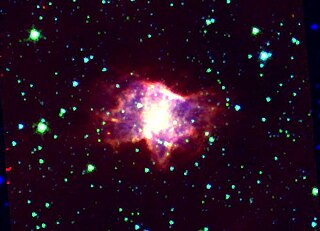
NGC 6072 is a planetary nebulae in the southern constellation of Scorpius. It has a dynamical age of 104 years. Its circumstellar envelope is likely to be rich in carbon as it has very strong CN (cyanide) spectral lines. CN spectral lines are generally not detected in oxygen rich AGB (asymptotic giant branch) circumstellar envelopes. NGC 6072 also shows H2 (hydrogen) emission and intense CO (carbon monoxide) emission which has been mapped displaying bipolarity and some gas at high velocity. The evolution of this planetary nebulae is likely to be dominated by photodissociation and ion/radical molecular reactions. Shock chemistry is also likely to be important.
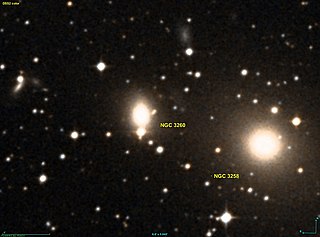
NGC 3260 is an elliptical galaxy in the constellation Antlia. It is a member of the Antlia Cluster, which lies about 40.7 megaparsecs away. It was discovered on May 2, 1834 by the astronomer John Herschel.

NGC 7026 is a planetary nebula located 6000 light-years away, in the constellation of Cygnus. The central star of the planetary nebula has a spectral type of [WO3], indicating a spectrum similar to that of an oxygen-rich Wolf–Rayet star. An analysis of Gaia data suggests that it is a binary system.
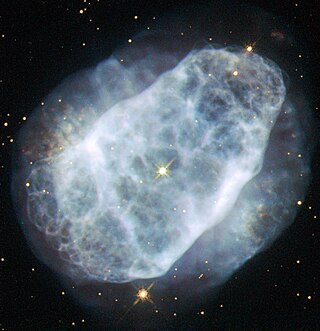
NGC 6153 is a planetary nebula in the constellation Scorpius. It was discovered in 1883 by Ralph Copeland.

NGC 120 is a lenticular galaxy of type SB0? pec? with an apparent magnitude of 13.4 located in the constellation Cetus. It was discovered on 27 September 1880 by Wilhelm Tempel.
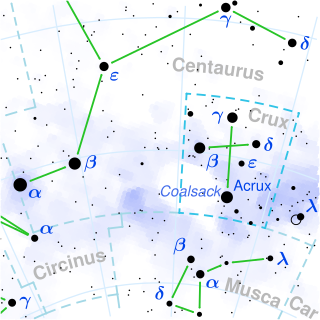
DS Crucis is a variable star near the open cluster NGC 4755, which is also known as the Kappa Crucis Cluster or Jewel Box Cluster. It is in the constellation Crux.

BU Crucis is a variable star in the open cluster NGC 4755, which is also known as the Kappa Crucis Cluster or Jewel Box Cluster.
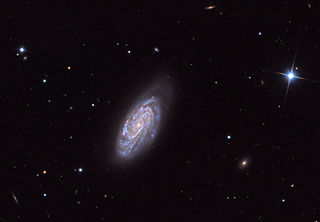
NGC 3294 is a spiral galaxy in the constellation Leo Minor. It was discovered by William Herschel on Mar 17, 1787. It is a member of the Leo II Groups, a series of galaxies and galaxy clusters strung out from the right edge of the Virgo Supercluster. The galaxy is located at a distance of 98 million light years and is receding with a heliocentric radial velocity of 1,586 km/s. The morphological class of NGC 3294 is SA(rs)bc, which means this is a spiral galaxy with no central bar (SA), an incomplete inner ring structure (rs), and moderately wound spiral arms (bc).

NGC 825 is an unbarred spiral galaxy in the constellation Cetus, estimated to be 154 million light-years away. The object was discovered by the astronomer Albert Marth on November 18, 1863.

NGC 5966 is an elliptical galaxy in the constellation Boötes. NGC 5966 is its New General Catalogue designation. The galaxy was discovered by William Herschel on March 18, 1787. Based on its redshift, it is located about 220 million light-years away from the Sun.

NGC 1570, mistakenly called NGC 1571, is a faint galaxy located in the southern constellation Caelum, the chisel. It has a blue magnitude of 13.2, making it visible through a medium sized telescope. Based on a redshift of z = 0.014760, the object is estimated to be 198 million light years away from the Local Group. It appears to be receding with a heliocentric radial velocity of 4,392 km/s.

















